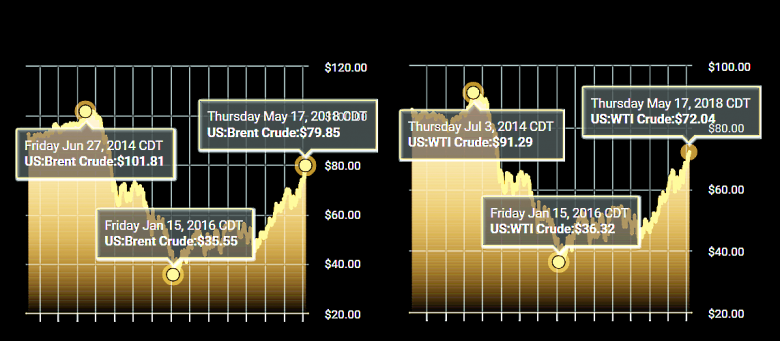
MARKETS IN BALANCE

EIA - The extended period of oversupply in global petroleum markets that began before the Organization of the Petroleum Exporting Countries (OPEC) November 2016 agreement to cut production has ended, and the large buildup of global inventories during that period has now been drawn down. As OPEC plans to reconvene on June 22, markets now appear more in balance, but uncertainty remains going forward.
The November 2016 OPEC supply agreement took effect in January 2017, whereby OPEC member countries agreed to reduce crude oil production by 1.2 million barrels per day (b/d) compared with October 2016 levels and to limit total OPEC production to 32.5 million b/d. In addition, Russia agreed to reduce its crude oil production. OPEC extended the agreement in November 2017, with the production cuts remaining in place until the end of 2018.
Since January 2017, one of the primary indicators of a tightening world oil market has been a decline in crude oil and other liquids inventories. After sustained increases in quarterly global liquid inventories from mid-2014 through most of 2016, inventories declined throughout 2017 and into the first quarter of 2018 (Figure 1).
Data for global petroleum inventories are not collected directly. Instead, increases or decreases in global inventories are implied based on the difference between world production and world consumption estimates. However, inventory data for the United States and for countries within the Organization for Economic Cooperation and Development (OECD) are available and can indicate what is happening globally.
From January 2017 to April 2018, U.S. crude oil and other liquids inventories decreased by 162 million barrels while OECD inventories decreased by 234 million barrels. Over this same period, U.S. and OECD crude oil and other liquids inventories moved from 229 million barrels and 334 million barrels, respectively, higher than their five-year averages to 16 million barrels and 2 million barrels lower (Figure 2).
Between the first quarter of 2017 and the first quarter of 2018, estimated total world petroleum and other liquids production rose 1.6 million b/d. OECD petroleum and other liquids production rose 1.3 million b/d, and most of this growth came from increased crude oil production in the United States, which increased by 1.2 million b/d, from 9.0 million b/d to 10.2 million b/d. Total OPEC petroleum (crude and other liquids) production increased by 0.4 million b/d over this period. Total OPEC crude oil production remained lower than the 32.5 million b/d agreement level, increasing 0.27 million b/d to 32.4 million b/d.
Total world petroleum and other liquids consumption, on the other hand, increased by an estimated 1.9 million b/d between the first quarters of 2017 and 2018, exceeding the growth in production and resulting in inventory declines. This consumption growth occurred primarily in the United States (0.6 million b/d), China (0.5 million b/d), and other Non-OECD Asia (0.6 million b/d) (Figure 3).
The days of supply measure (current inventory level divided by next month's estimated consumption) provides additional insight into market balances. Between January 2017 and April 2017, U.S. and OECD crude oil days of supply fell by 11.5 and 4.5 days, respectively, to 59.2 and 60.6 days. U.S. crude oil and other liquids days of supply fell from 12 days higher than the five-year average to 3.6 days lower. OECD crude oil and other liquids days of supply dropped from 7.4 days higher than the five-year average to 1.6 days lower (Figure 4).
EIA forecasts that the tightening trend in global petroleum markets will reverse. EIA forecasts that both U.S. and OECD petroleum and other liquids inventories will return to surpluses compared with their five-year averages, although on a smaller scale compared with the period between 2015 and 2016. U.S. and OECD days of supply are forecast to remain in a band that is close to the five-year average level through 2019. However, additional uncertainty about future global oil market balances remains in light of, among other factors, the U.S. withdrawal from the Joint Comprehensive Plan of Action (JCPOA) and the continued instability in Venezuela.
-----
Earlier:

2018, May, 16, 12:35:00
OIL PRICE: ABOVE $77 ANEWREUTERS - Brent crude futures were at $78.22 per barrel at 0644 GMT, down 21 cents, or 0.3 percent, from their last close. U.S. West Texas Intermediate (WTI) crude futures were at $71.03 a barrel, down 28 cents, or 0.4 percent, from their last settlement. |

2018, May, 16, 12:30:00
OIL MARKET BALANCEPLATTS - "It is too early to say [what the impact of the US decision on the oil market will be]. In any case, we have all the tools that could be used to balance the market," Novak said, commenting on the potential impact of the move on the oil markets. |

2018, May, 16, 11:55:00
U.S. OIL PRODUCTION + 144 TBD, GAS PRODUCTION + 1,092 MCFDEIA - Crude oil production from the major US onshore regions is forecast to increase 144,000 b/d month-over-month in June from 7,034 to 7,178 thousand barrels/day , gas production to increase 1,092 million cubic feet/day from 67,027 to 68,119 million cubic feet/day . |

2018, May, 14, 11:30:00
SAUDIS - RUSSIA COORDINATIONFT - “Any action will be taken in co-ordination with other producers,” the person said on Wednesday, adding that Saudi Arabia was already in talks with Russia and other producers, including the UAE. |

2018, May, 10, 13:10:00
OIL MARKET STABILITYPLATTS - Saudi Arabia's energy minister Khalid al-Falih said Wednesday that the country would work closely with OPEC as well as non-OPEC producers to mitigate the impact of any shortages that might arise following the US' decision to withdraw from the Iran nuclear deal. |

2018, May, 4, 15:35:00
RUSSIAN CONFORMITY THE DEALPLATTS - On Wednesday the Central Dispatching Unit said Russia produced 44.878 million mt of liquids in April. This is equivalent to around 10.965 million b/d, using Platts conversion rate of 7.33 barrels per metric ton. This indicates Russia's compliance was 94%, at 282,000 b/d below the October 2016 level of 11.247 million b/d. |

2018, April, 27, 11:15:00
БАЛАНС МИРОВОГО РЫНКАМИНЭНЕРГО РОССИИ - Александр Новак, говоря о перспективах соглашения о балансировке рынка, отметил, что участники рассматривают несколько вариантов дальнейшего сотрудничества. «Главная задача – не создать условия для дисбаланса на рынке», - заключил Министр. |








